

My first experience with Deity difficulty in Civ7 was going well thus far. I exited the Ancient era with the most settlements in the game, comparable to superior culture and science generation compared with the other AI empires, and with my biggest rival Catherine already dead and buried underground. The Civ7 AI falls apart worse and worse with each additional era so if anything the gameplay should only get easier from this point. First I had my choice of which civ to pick for the second era:
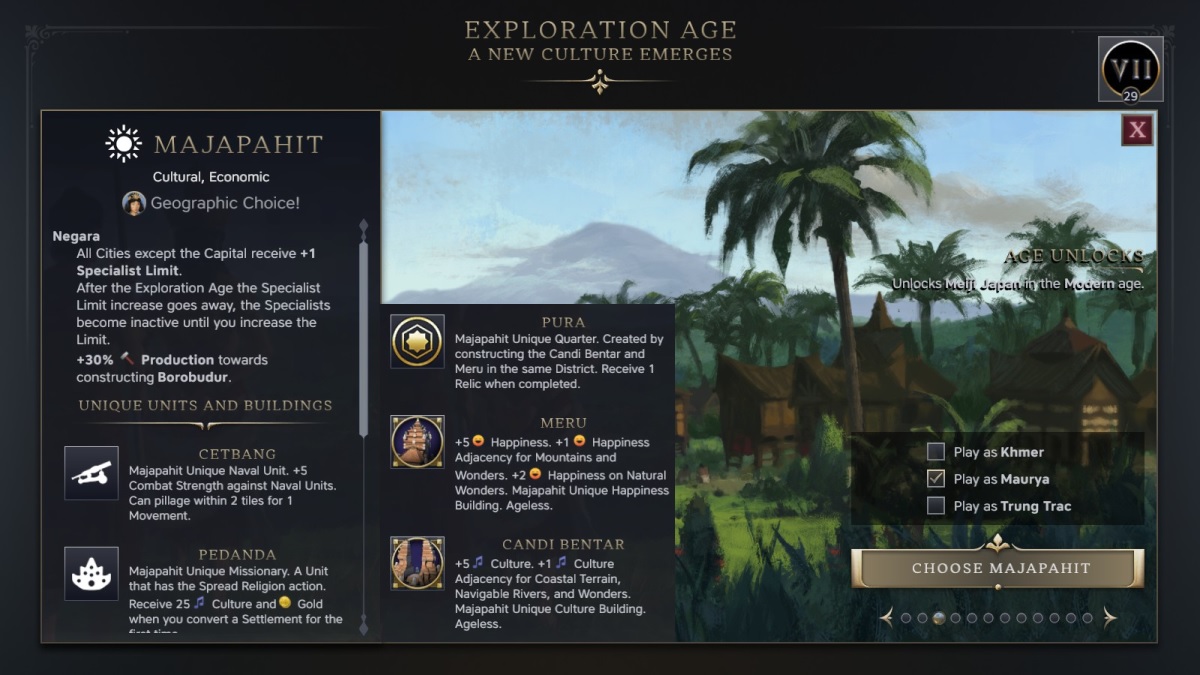
I wanted to continue testing out new civs and therefore picked the Majapahit, an Indonesian-based empire. The Majapahit have the unique ability of granting an extra rank of the specialist limit, which makes hitting the Scientific scoring goal a good bit easier for this era. I haven't had much trouble landing that particular legacy though so this doesn't feel like an especially poweful ability. The Majapahit also have a unique naval unit that gets +5 strength against other naval units and a unique missionary that provides a truly paltry amount of gold and culture on converting settlements. The Pedanda has to be on the short list of worst unique units in the game as 25 gold / 25 culture is insultingly low by this point of the gameplay. (Civ7 has a lot of stuff like this where the developers clearly did not understand how yields scale up over the course of the gameplay.)
The real advantage of the Majapahit is their unique district known as the Pura. This one contains buildings with +5 happiness and +5 culture respectively, with the cultural Candi Bentar having an unorthodox adjacency bonus for coastal tiles and rivers which often allowed me to get something like 7-8 culture in practice. The unique quarters benefit for completing the Pura was the awarding of a relic which makes it very easy to complete the Cultural scoring goal for this era. The player can easily build a Pura in every city and that's at least half a dozen of the 12 required relics without needing to mess around with missionaries. Overall then, I'd rate the Majapahit as a bit above average while not being at the top of the tier list.
I did remember to change mementos and swapped out the 200 gold per age option (great for the Ancient era but bad afterwards) for a new memento providing +1 influence per age on science buildings. This memento only operated on buildings from the current era, not obsolete buildings, but I'd be getting 2 influence on every observatory and university which felt quite useful.
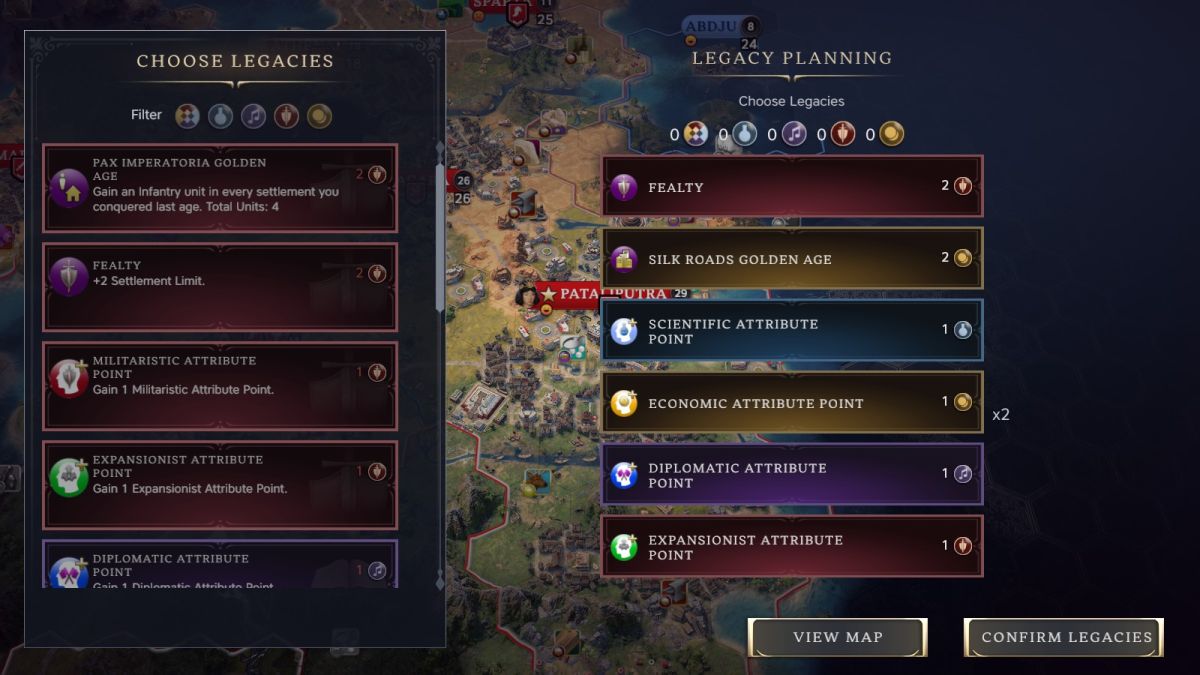
For the legacy options, I made sure to take the two most important options in Fealty (+2 settlement limit) and the Silk Roads Golden Age so that all my cities remained as cities instead of becoming towns. I had four cities from the Ancient era (and would have had a fifth given another turn or two) and I could have retained only two of them if I hadn't achieved this legacy. Everything else went into various attribute points to advance me further down their respective trees. Now I had to go through the tedious process of setting up my whole civ again after control was rudely yanked away by the era transition. I've written about this in my past reports so I won't belabor things too much but I absolutely hate this aspect of Civ7. Every transition breaks the immersion of running a continent-spanning empire and makes me feel as though I'm taking control of a succession game following turns run by a particularly bad player. I had to go through and pick new builds at every city, pick new techs and civics, assign all the resources, figure out where all my units had teleported, etc. Someone please create an ageless version of this game already.
I also had to assign new specializations for my handful of towns. Most of my settlements were intended to become cities eventually, however I did have a town south of Pataliputra and a couple more in the far northern tundra that I had captured from Catherine. The best thing to do with these was convert them into "hub towns" where they generated 2 influence for each connected settlement. The town of Tosali had eight connections worth 16 influence/turn which was far more useful than becoming a farming/fishing town for slightly more food generation. These hub towns would be key to taking control of the various independent powers scattered across the map.
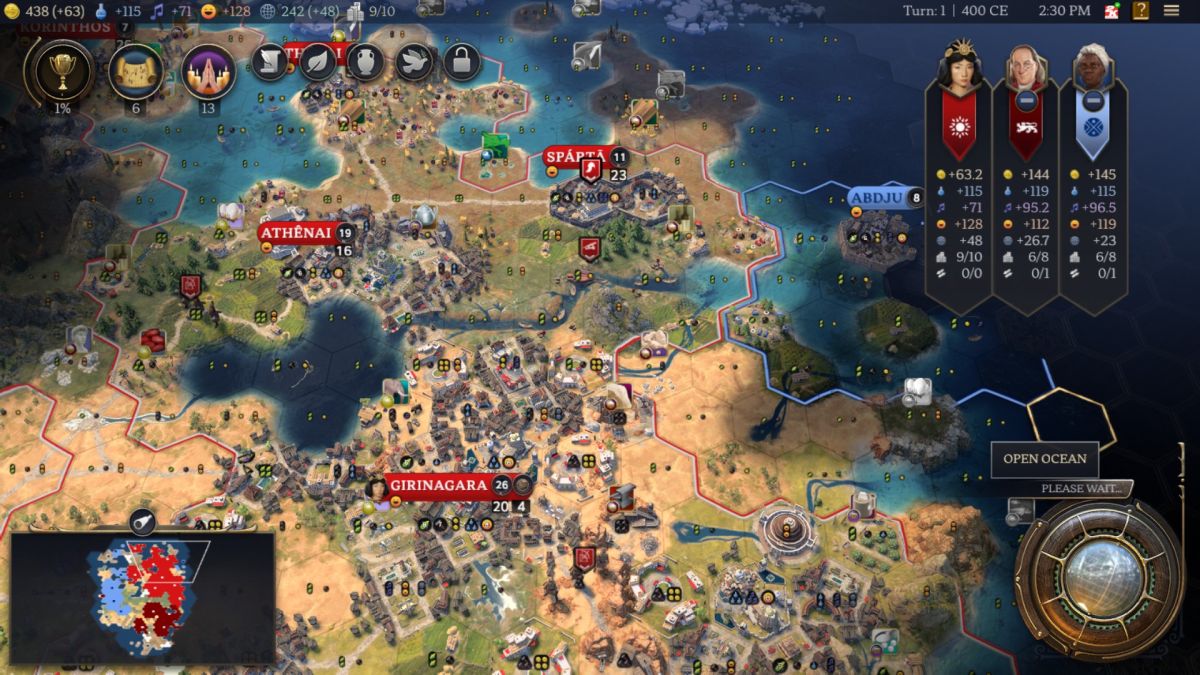
The northern portion of my territory looked like this once I had finished reconfiguring everything. I had been able to preserve most of my science thanks to gaining two additional Scientific attribute points, dropping only from 132 to 115 beakers/turn which was a reasonably good place to be for the start of this age. Culture had been hit much harder, falling from 129 to 71 culture/turn due to the ending of my alliances with a bunch of city states, each of which had been granting my monuments +2 culture per alliance. I'd have to build this up again from scratch, hooray. The good news was that the settlement limit had gone up substantially, from 9/6 at the end of the previous era to 9/10 now, meaning that there was plenty of happiness room to go out expanding again. I believe that I've written the same thing about pretty much every era transition across my multiple Civ7 reports which should help indicate how repetitive the gameplay can be in this regard. There are so, so many places where Civ7 railroads the player for no reason at all; for example, why does there need to be a settlement limit at all? How about the map just fills up until all the available land is gone, with everyone contesting each other for land and resources? That seems like it would work pretty well to me.
I was prompted to pick a government on Turn 2 and I decided to try Feudal Monarchy on a lark. This government grants +20% food as a celebration option (the other option is the terrible +30% production towards training cavalry and naval units) and I thought I'd experiment with this given the changes to the city growth formula in this patch. After having played this game, I still think that my normal choice of Plutocracy for +20% gold or +30% production towards overbuilding during a celebration is better, though the extra food was noticeable and a lot better than it would have been before. Something that I did not expect was that Benjamin Franklin would also choose Feudal Monarchy for his government, which then granted me a big diplo boost thanks to his unique leader agenda. It may very well have been worthwhile to take this government solely due to the diplo benefits as Franklin soon became a strong ally.
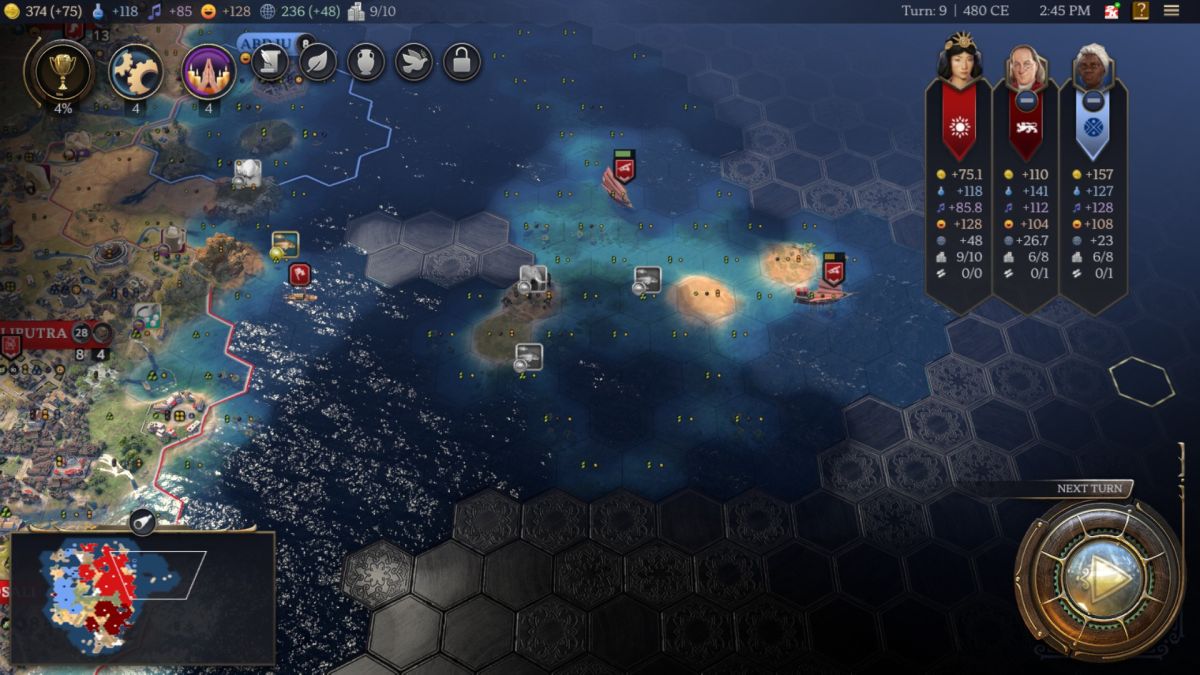
The main thing that I wanted to do in the early Exploration age was start settling more towns overseas. I needed to acquire 30 treasure fleet resources before the end of the era to land the Economic Golden Age, which meant claiming territory in "distant lands" since that's the only place where those resources appear. I also knew that there would be huge open spaces on the other continent since I had removed one of the AI leaders before starting this game. As a result, I started out the age by researching Cartography tech to allow settlers to cross ocean tiles, then immediately sent out several ships exploring with a trio of settlers following in their wake. I had a real weakness here of possessing mostly landlocked cities, with only the capital of Pataliputra situated along the coast. The Catherine conquests would help remedy that with time but I had only just been able to upgrade Athenai into a city and it still needed a lot of improvement.
My initial ships began crossing the eastern ocean and found... almost nothing? It took three turns of ocean crossing to stumble across these flyspeck islands with nothing of value located on them, followed by another three or four turns of ocean crossing to arrive at the eastern distant lands. In fact, the passage was so rough that I had to stop and heal my ships and later settlers at the halfway point or else they would perish before reaching the other side. Needless to say, there were no treasure fleet resources to be found here and barely even any land at all. It was certainly a contrast from the GOTM #2 game where I barely had to make any effort to find two large islands packed with those resources. I don't know if this is a quirk of the Terra Incognita map script or if something changed in the map generation in Patch 1.2, it was certainly a different setup though.
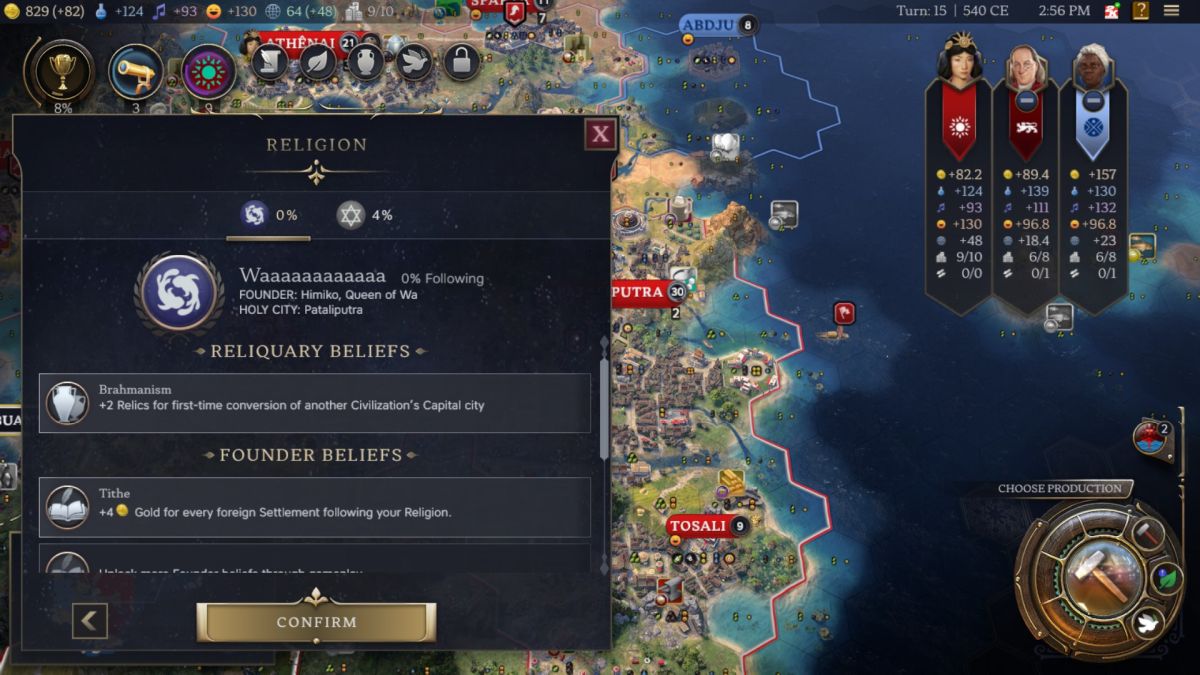
Back at home, I launched the initial colonization fleet and then returned to the task of replacing my Ancient era buildings with their Exploration age counterparts that did the same thing with slightly higher yields. I had to start my civics research with Piety so that I could found a religion before all the best beliefs were taken; the player basically has to open with Piety every single time for this reason. Even though I beelined to a religion, I still was beaten there by someone else who took the belief I most wanted: the one that grants 2 relics on first time conversion of a city state. I had to fall back on Brahmanism which would grant me exactly 2 relics the whole game when I converted Franklin's capital. At least those unique Pura districts would give me all the relics I needed as I otherwise ignored religion as usual.
I was also using my gigantic advantage in influence generation, where I had nearly triple the influence of anyone else, to start taking control of all the various independent powers. There were four of them on my continent and I hoped to befriend all of them, starting with the nearby Cultural IP in between Samara and Korinthos. There was also a Commercial IP a little further to the south where I ran interference for Franklin's units, standing next to the independent power so that he couldn't attack and kill it as he was trying to do. That was enough to preserve it for a future friendship which I eventually turned into a bunch of Company Posts. I also used my influence to block a denunciation from Harriet Tubman: by spending 120 influence, I stopped our relations from dropping by 60 points. This is almost always a sign that an AI leader is about to attack the player and therefore I effectively stopped hostilities before they could start. Influence is powerful in this game!

It took an unusually long amount of time to reach the distant lands continent thanks to the lack of islands between them. I finally managed to get my first settlement established over there at Lumajang on Turn 25 by which time my ships had scouted out a decent portion of the coastline. As soon as Lumajang was established, I bought a cheap scout to help explore what else was over there and I'd be able to purchase future settlers inside once I had the money to spare. The other two settlers who had made the ocean crossing were on their way to found additional settlements to the southwest, both of them still bearing heavy wounds from the rough seas. Fortunately this seemed to be an empty part of the map without barbarians or hostile enemies to worry about; I guess this is where the fifth AI leader would have spawned.
My main target continued to be those treasure fleet resources since I needed to generate 30 of them before the end of the era. The most recent patch has added a visual indicator to the treasure fleet resources which looks like a gust of wind; there were two of them at Lumajang and I'd spotted two more of them further southwest where another settler was heading. I made certain to connect them as quickly as possible and cash-rush a fishing quay to connect these settlements back to the rest of the empire. That still wasn't enough to start generating the treasure fleets, however, since the player also needs to have Shipbuilding tech researched. This is a really obnoxious requirement that makes it even harder to achieve the Economic legacy goal and all I could do was proceed to the tech at max possible speed.
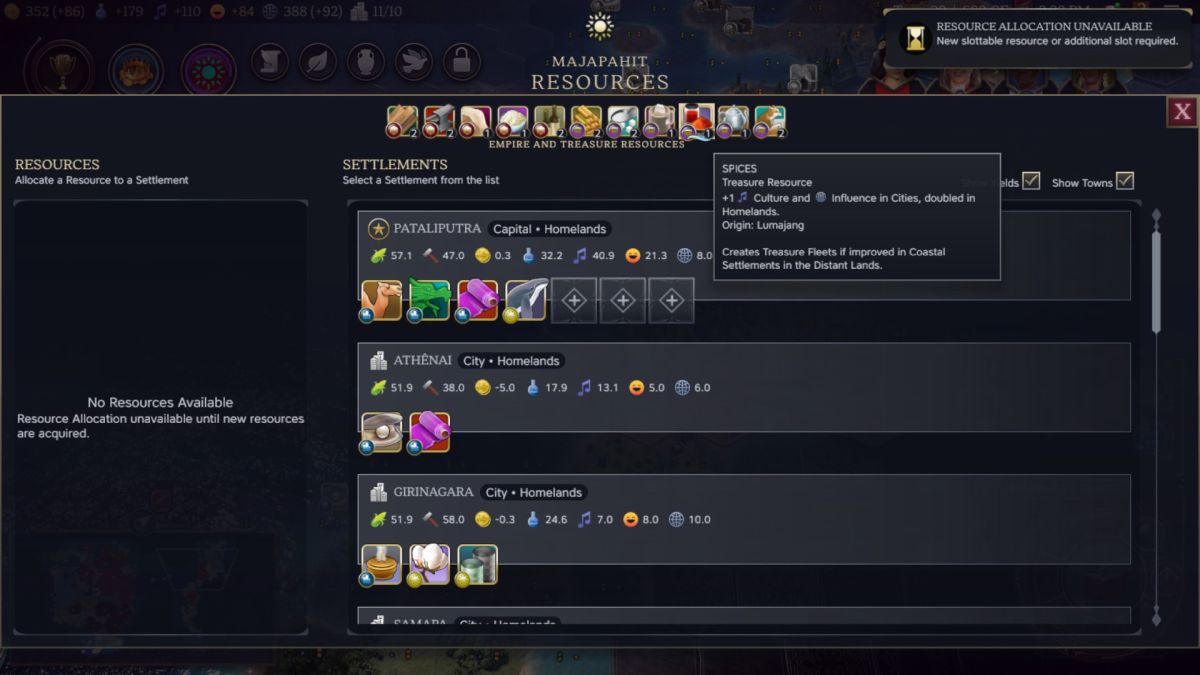
In earlier versions of Civ7, the treasure fleet resources did absolutely nothing aside from generate those fleets for scoring purposes. They have been updated in Patch 1.2 to provide powerful empire-wide benefits, such as the highlighted spices granting 1 culture and 1 influence per city, doubled for cities in the homelands for some reason. I had six cities back on the original continent at this point so this single resource was worth an awful lot of culture and influence. Some of the other new benefits include sugar providing +1 food and +1 happiness per city, tea providing +1 science and +1 production per city, and the new limestone resource (which is not a treasure resource) granting +10% production on buildings everywhere. These new resources are really fun to have and they create a real incentive to want to control them, as opposed to collecting the treasure fleet resources solely because the game told the player to do so. I was picking my settlement spots over on the other continent specifically to gobble up these resources and reap the empire-wide benefits that they provide. This is an excellent improvement from the recent patch.
The big downside? There simply weren't very many of these things:
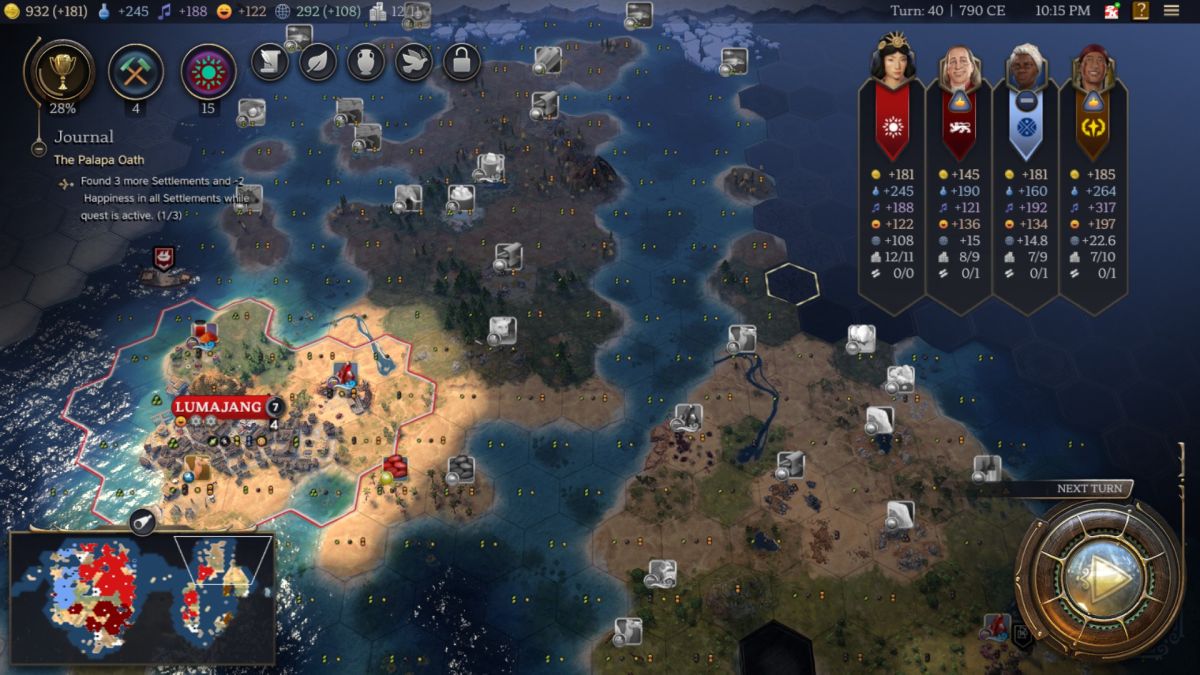
Ever since Patch 1.2 released, the treasure resources seem to be extremely scarce. They simply did not appear anywhere in the archipelago island chains on this map, and they remained slim pickings on the distant lands continent. I had about a third of the continent visible in this screenshot and there were a mere five such resources to be seen: two at Lumajang, two more to the east across that narrow channel of water that I planned to target next, and then one solitary tea resource in the north which hadn't been there at all until I took a goody hut event that added the tea to the map. After defogging the whole map, I tallied up the treasure fleet resources and foud that there were only 14 of them present on the whole map, again with none of them located on the island chains. I would eventually settle towns to control 8 of them which I hoped would be enough to achieve the treasure fleet legacy goal. Another four were buried deep in Tecumseh's territory and the remaining two were snapped up by Tubman and Franklin with one apiece. But remember, I had removed one AI from the map before starting this game; how in the world is a player ever supposed to get enough of these things under normal conditions? Everyone online is claiming that it's nearly impossible to achieve the Economic scoring goal now, which is really bad since that's the one that protects your cities from falling into towns on the era transition. More on this in a bit.
Speaking of Tecumseh, he was the other AI leader who had spawned on the distant lands continent. With no competition at all, he was definitely doing the best of my rivals though he inexplicably hadn't settled very well. If left undisturbed by warring, the AI leaders all seem to expand at the same pace as they always seem to have roughly the same number of cities as one another. Tecumseh had an enormous amount of culture for some reason and for the moment I was hoping to stay on good terms with him. The last thing I needed was an overseas war with me at the end of ridiculously long supply lines.
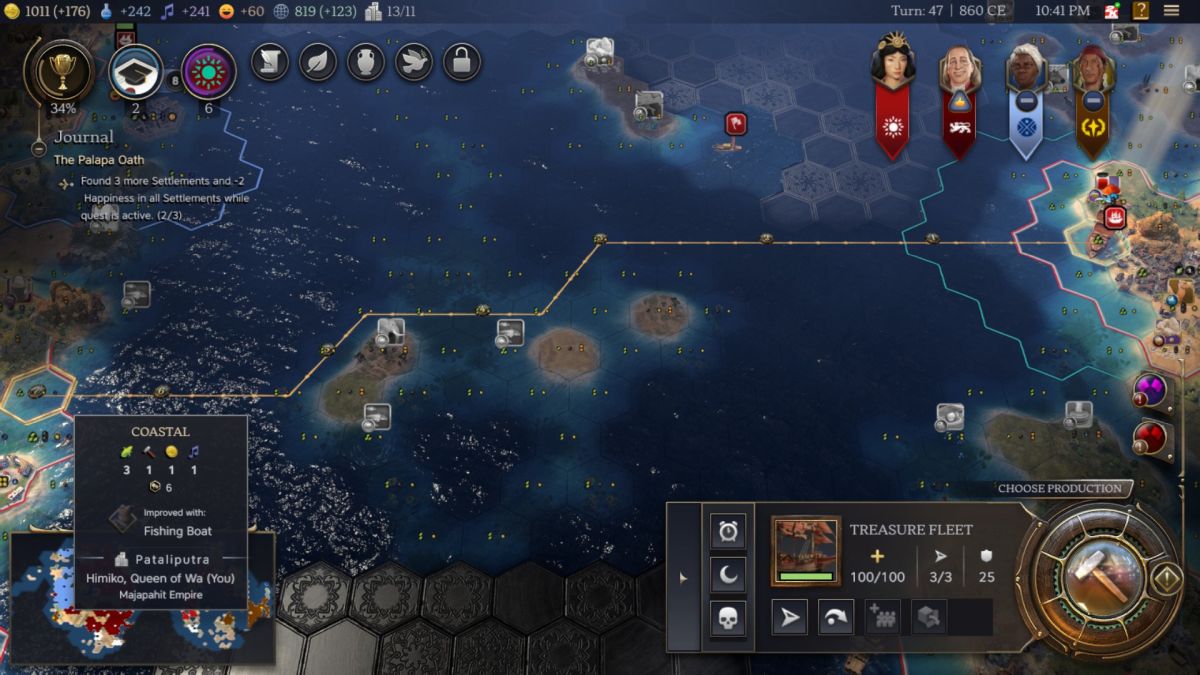
I had also taken that previous screenshot on Turn 40 because it was the same turn that I discovered Shipbuilding tech. Remember, it's not enough to settle the treasure fleet resources; the player must also have Shipbuilding tech, then wait eight turns for each settlement to generate a treasure fleet, then ship them back home across the ocean and collect 30 such fleet points before the era ends. This is a glacially slow process and there's nothing that can be done to speed it up, the treasure fleets can't be generated any faster and then they must be moved across the world map to drop off their cargo. Since I had discovered Shipbuilding tech on Turn 40, the first treasure fleet popped up on Turn 47 (due to some weirdness in how the eight-turn duration gets calculated for the initial fleets) and then had this lengthy voyage back home. Note that Lumajang was the CLOSEST of my various overseas settlements, with some of the others having 9 or 10 turn travel times for the fleets to make it home. And again, I *HAD* to do this or else every city aside from my capital would degrade into town status upon beginning the next era. I would like Civ7 so much more if I could just play the dang game as opposed to having to engage in these stupid minigames over and over again.
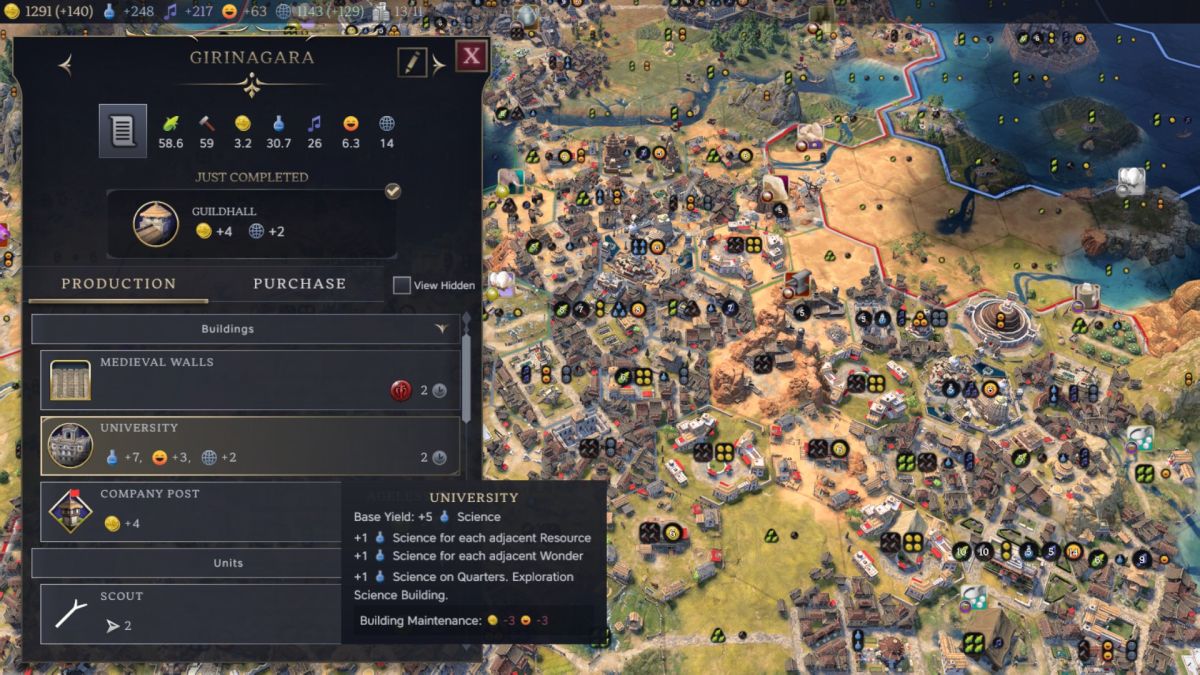
Back at home, I'd been happily building away across my core cities for the entirety of the era. I had outstanding relations with Franklin by this point while Tecumseh declared war against Tubman on Turn 49 to remove her as any kind of threat. Excellent news, now both of you go away and leave me alone to play in my sandbox. I followed my normal path through the Civ7 tech trees by emphasizing production buildings and science buildings, with the other stuff getting secondary priority. I had some juiced up science buildings in this game as demonstrated in the screenshot: observatories and universities were both getting +3 happiness from one of my Mauryan traditions and a further +2 influence from the memento that I had taken before the age started. This made them incredibly valuable commodities and I could pair them with the Majapahit unique quarter for some culture and even more happiness. This allowed me to go well over the settlement limit without feeling any ill effects; the biggest limitation on expansion right now was finding decent land to plant more cities.
Thus I kept building away like a happy little beaver, and the effects of that continued to add up with time. My massive influence stockpile was also starting to bear fruit as I had earlier started the friendship countdown with essentially every independent power on the map. First I gained the benefits of the IPs on my continent, then increasingly the ones that I had found over in the distant lands as well. I was soon getting 5% more gold and science per city state friendship and that was a lot once I had half a dozen of them under my control. I think this is one of the easiest ways to get a big lead over the AI leaders and it's a playbook that can be run in seemingly every game.
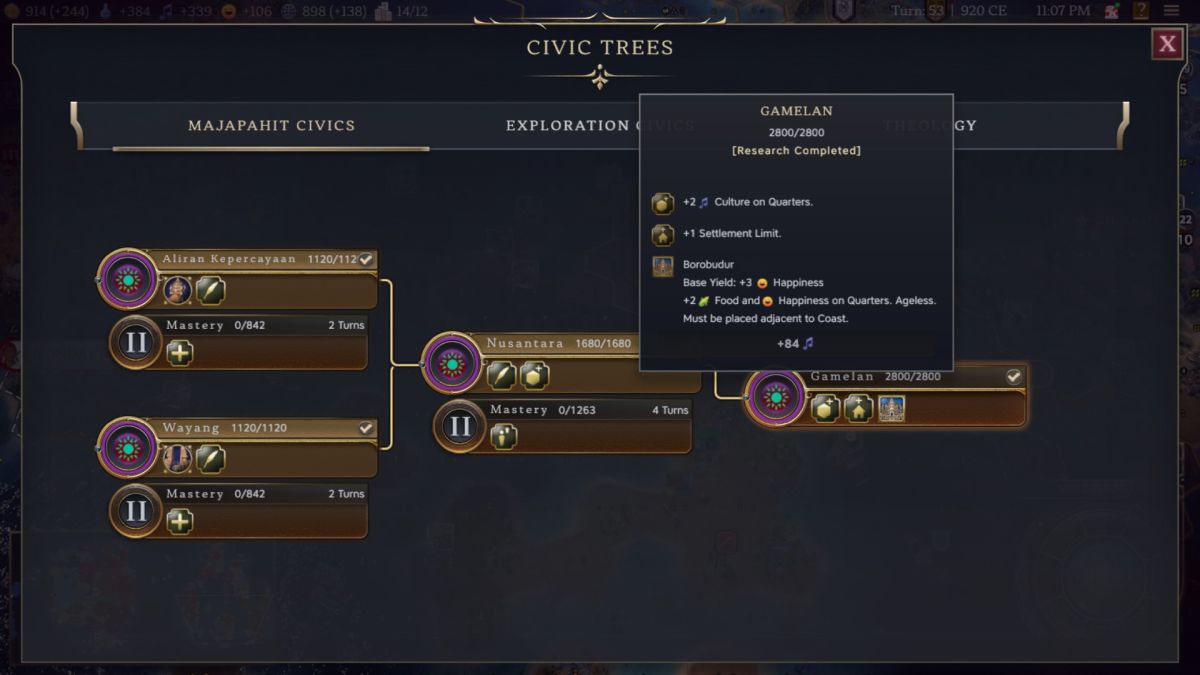
On the civics tree, I had picked up that initial Piety civic to found my religion, then I went deep into the Majapahit unique civics tree afterwards. The main civics tree in the Exploration age has a lot of good stuff in it, namely a whole bunch of +1 settlement limit and +1 policy card slots, however what it lacks are good policies themselves. Almost all of the standard policies in the Exploration age are downright terrible and therefore I didn't feel compelled to spend my culture there. Instead, I unlocked the two Majapahit buildings so that I could construct the unique quarter, then I pushed for the expensive Gamelan civic at the end of the tree for its passive benefit: +2 culture on quarters. That was very, very powerful indeed as my interface mod was helpfully indicating, worth 84 culture/turn already and continuing to scale upwards as more quarters were completed. There was nothing anywhere else on the various civics trees that could equal this benefit and so therefore I finished the entire Majapahit civics tree on Turn 53, having researched nothing else besides that initial Piety. This was enough to boost me into the worldwide lead on culture:
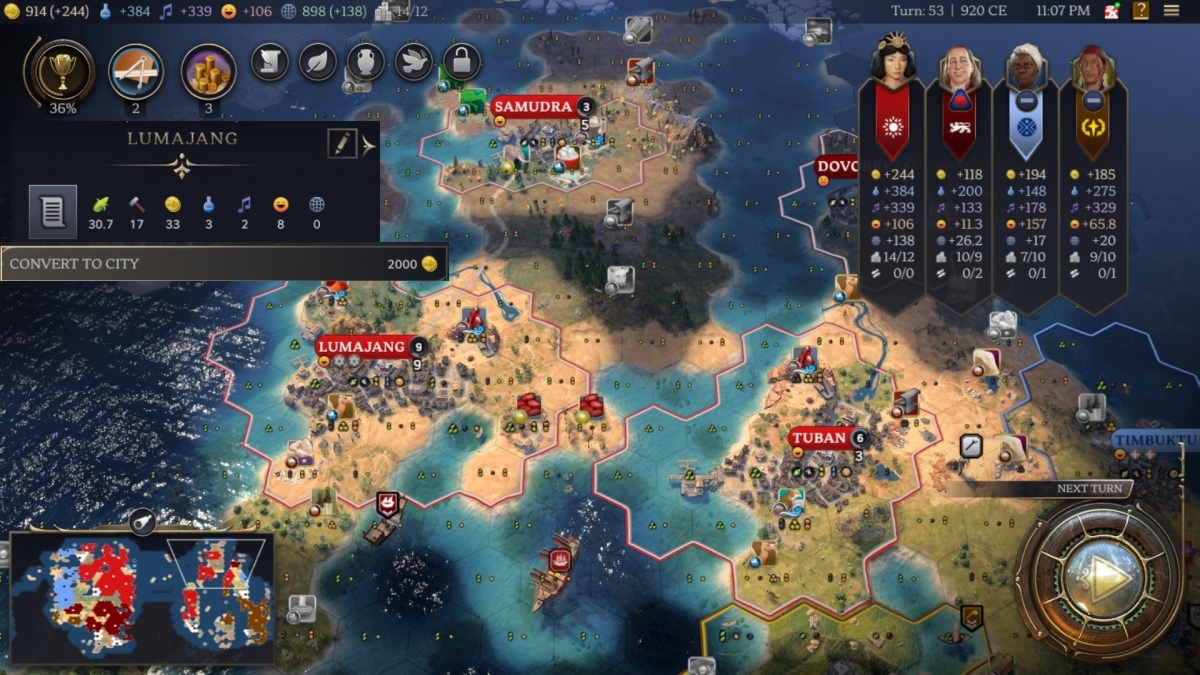
Tecumseh had not grown his earlier lead in culture and I had eclipsed his performance, while also taking a clear lead in science as well. The other two AI leaders had fallen well behind the pace and would have been left hopelessly backwards without the future era transition into the Modern era to catch them up. Since the last time that I showcased this part of the map, I had also settled Samudra and Tuban to control the various treasure fleet resources in the area. I had immediately connected those resources with rural improvements and purchased fishing quays in each of them but there was nothing I could do to speed up the slow generation of those treasure fleets. The land between Lumajang and Samudra was almost but not quite strong enough to be worth establishing another settlement; if I had to play this over again, I would have moved Samudra one tile further north and then put another city east of those pigs to connect the whole region together. Oh well.
A few turns later I was able to upgade Lumajang from a town into a city, and check out that price at 2000 gold (!) This is another change in Patch 1.2 as previously the city upgrade cost was capped at 1000 in all eras. Now it's 1000 gold maximum in the Ancient era, 2000 gold in the Exploration age, and 3000 gold in the Modern era. That's really, really expensive even for a civ in excellent shape and probably out of the question for more than a handful of cities when less experienced players are at the helm. Thus the developers have done two things simultaneously: made it MUCH harder to acquire treasure fleet resources while also making it MUCH more expensive to upgrade towns into cities. Can you see where this is going? It's harder than ever to achieve the Economic golden age legacy, and if the player fails to do so, the penalty is far more severe than it used to be. This is not the direction that the developers should be taking!!! 
I don't mind it being expensive to upgrade towns into cities, really I don't. That's perfectly fine and helps make gold a valuable commodity to have on hand. But pairing this mechanic with era transitions that by default collapse every city back into towns is an absolutely horrific idea. No wonder the typical casual player isn't having fun while playing this game!
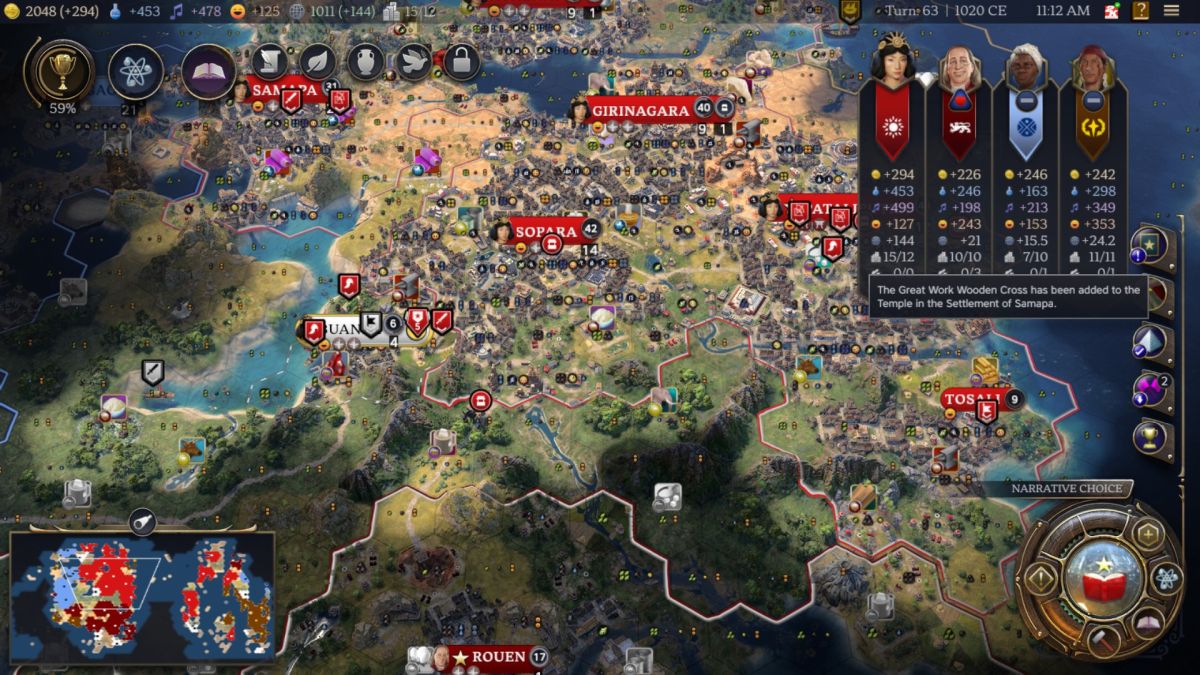
If I couldn't speed up the treasure fleet generation process, then the best that I could do was delay the upcoming era transition for as long as possible. Many readers will no doubt already know where this was heading: deliberately holding off on the legacy scoring goals and then rushing to fulfill them all simultaneously at the last moment. I hate that gamey nonsense but Civ7 practically forces the player to engage in those shenanigans. For the Economic category, I could park my treasure fleets in my territory without cashing them in, thus technically failing to score any of the points until the last second. I could also hold off on converting any of my distant lands settlements to my religion, then convert all of them simultaneously for the Military points on the final turn. The Science category was tougher because specialists can only be assigned on city growth; I figured that I would get 4/5 tiles with the 40 yield mark, then hold off on the fifth one until I was ready to end the age. If I missed the last Science point, that was fine. (I would later land the fifth Science point unintentionally when some empire-wide bonus to specialists boosted one of my tiles from 38 to 40 total yield.)
For the Cultural legacy goal, the player has to collect and display 12 relics in their cities. This was trivially easy to do with the Majapahit unique quarter providing a relic each time that I completed one, and I planned to hold the relics in reserve until I was ready to finish the era. This worked as expected with the two relics that I acquired from converting Franklin's capital to my religion, as they sat in the great works inventory until I placed them. However, the relics that came from the Pura unique quarter were automatically assigned into the relic slots of my temple, without even asking me! I snapped a picture when this happened on Turn 63 because I was so upset - what the heck, game! I didn't want that relic to be placed in there because it took me to 6/12 relics and the first tier scoring goal for the Cultural category. This ticked up the blasted era meter, which had been sitting at 36% on Turn 53 and had climbed to 59% a mere ten tuns later on Turn 63. I was not a happy camper with even less time available before the era transition would appear.

There were times here where I had spare production and spare influence which allowed me to do something novel: play around with trade routes. By default the player can run a single trade route to each civ, and they can spend influence to unlock additional trade routes over and over again, with no limit as far as I know. Civ7 flies by at such a fast pace that there are normally more important things to spend production and influence on, however since I wasn't having to train military units in this era, I had a bit of a breathing room to engage in these luxuries. I tried to target the valuable empire-wide resources possessed by Franklin and eventually set up three trade routes with him along with two trade routes with Tubman. I think this might be a fun concept to base a game around if the AI wasn't always attacking me and I didn't have to stress out about the era transitions always lurking in the background.
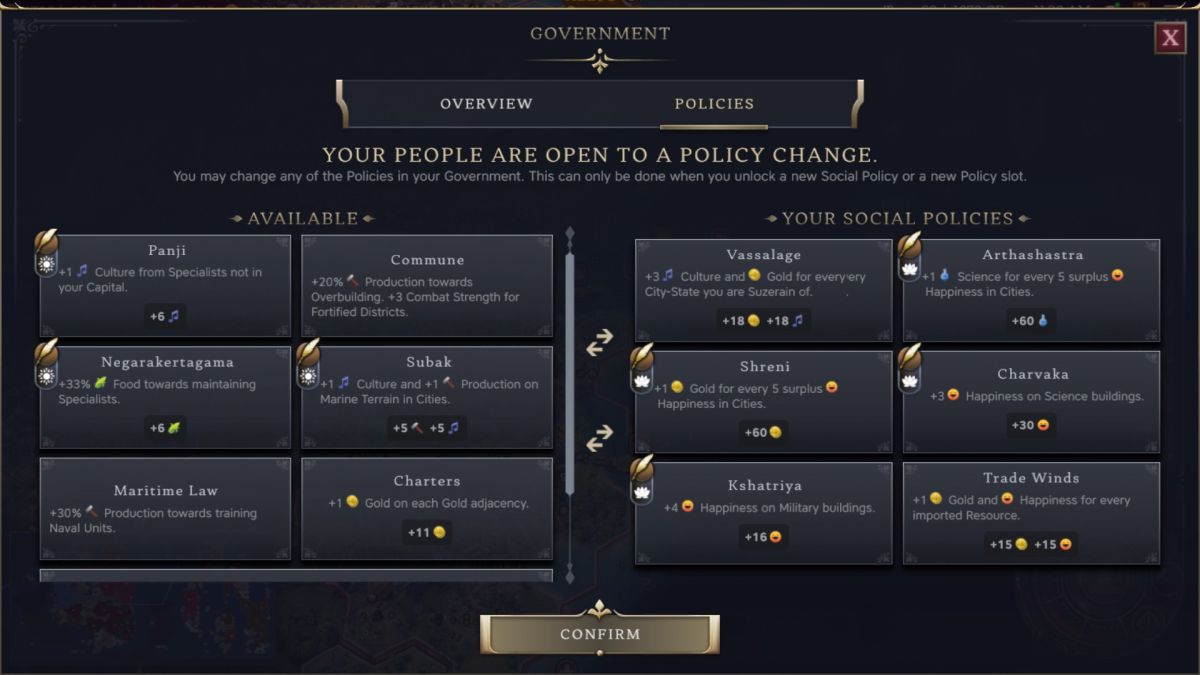
And these were the policies that I was running for the curious. I had a bunch of policy slots because my high degree of happiness had translated into a lot of celebrations over the course of the age. One thing that I want to highlight is that the policies continue to be atrociously balanced in Civ7, with no rhyme or reason as far as which ones are stronger than the others. Note that I was still running all four of the Mauryan traditions from the previous era because they were way better than everything else available here in the Exploration age. The older Mauryan traditions were also superior to the new Majapahit traditions as well, which surely shouldn't have been the case across the board. Even Vassalage and Trade Winds were only useful to employ because I had more city state friendships and trade routes than would be the case in a typical game, normally they're pretty weak as well. I wish that the game had more useful policies so that I felt more interest in diving into the civics tree to unlock them. Instead, there's a bare handful of overpowered policies that I run in most every game while everything else barely gets used.
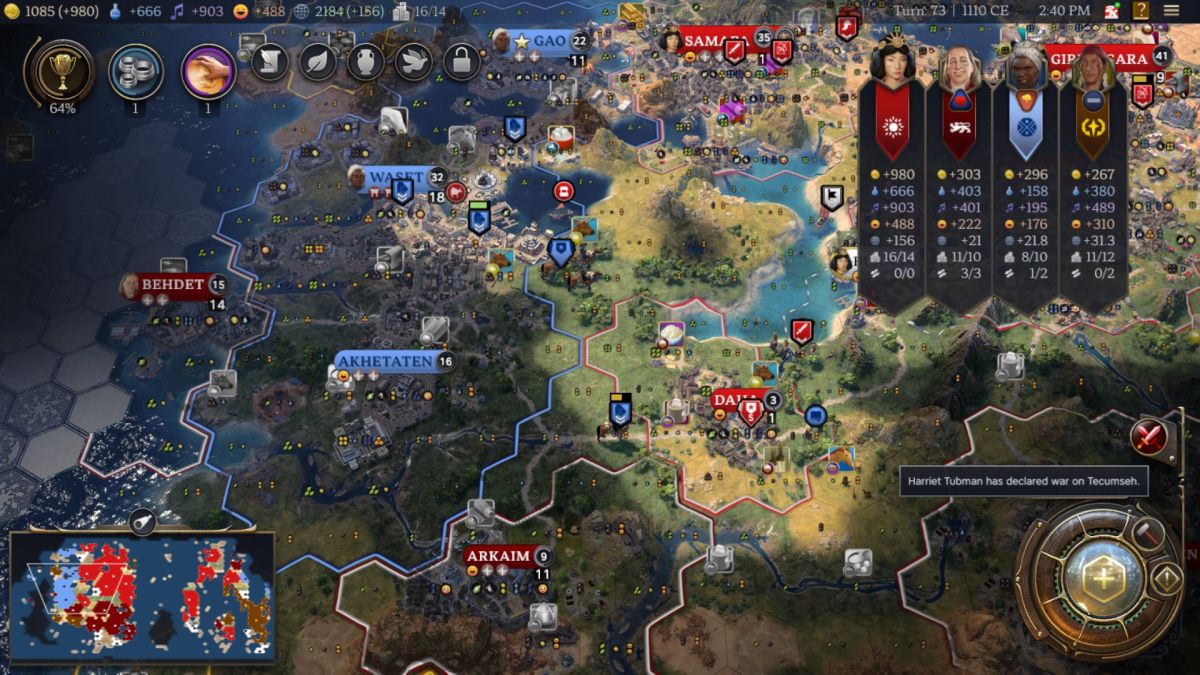
By the time that Turn 70 rolled around, I had raced far out in front of everyone else in the game. My core cities had essentially finished with all of the main Exploration age buildings, I had upgraded five different towns on the distant lands continent into cities, and my friendships with all of the independent powers had matured into full alliances. While Tecumseh and especially Franklin had improved their science/culture/gold outputs markedly in recent turns, they were nowhere close to what my civ was putting out. I had half again anyone else's beaker rate, double anyone else's culture, and more than triple their best gold income. I was also crushing them all in happiness despite being over the settlement cap while they were mostly under the limit. Wasn't this supposed to be Deity difficulty? All that I needed was 75 turns where I wasn't being attacked by someone and it was enough to leave them all in the dust.
It helped that the three AI empires had been engaged in pointless warfare for some time. First Tecumseh and Tubman had fought each other, then Franklin had clashed with his western neighbor, and now Tubman had gone to war with Tecumseh again (thus not getting her +5 war support benefit since she started the conflict). In fact, I would have allied with Franklin much sooner except that I knew it would plunge me into a war with Tubman which I had wanted to avoid for most of the age. However, with my homeland cities having finished up with most of their infrastructure and Harriet Tubman already tied up in multiple wars, this felt like an opportune moment to make gains at her expense. I started training some units in my cities and upgrading the ones that I did have to their tier 3 versions since I had just about completed the tech tree and had plenty of spare cash to burn.
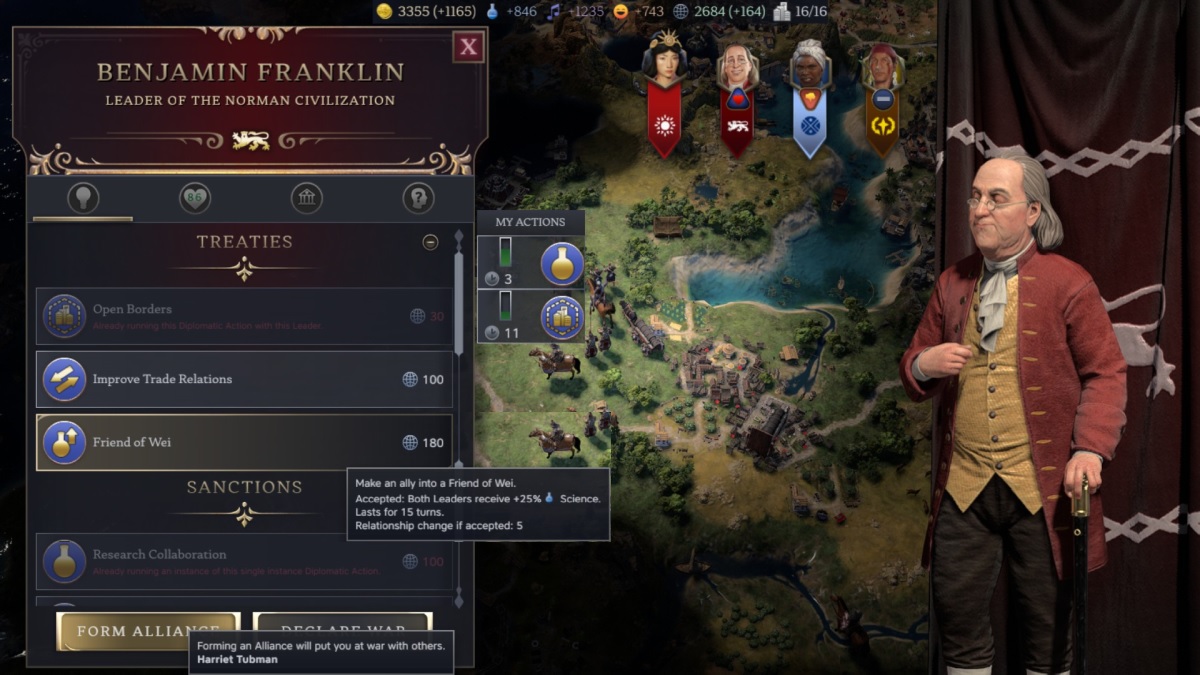
I was ready to move shortly after Turn 80. Although I had lots of influence available, I had forgotten to denounce Tubman until it was too late and would have to take the penalty for a Surprise War instead of a Formal War, whoops. I dialed up Ben Franklin and agreed to the alliance that he'd been dangling for some time, then finally had the chance to use the "Friend of Wei" unique endeavor unlocked by my leader Himiko. That was worth a whopping 25% additional science and she can theoretically have a bunch of these running at the same time. I've seen screenshots of some truly fanastic amounts of science when playing as Himiko though I'd have to be content with the beaker count topping 1000 for the first time, an excellent amount for the Exploration age. With Franklin and Tecumseh as allies, I was now pledged to warfare with Tubman.
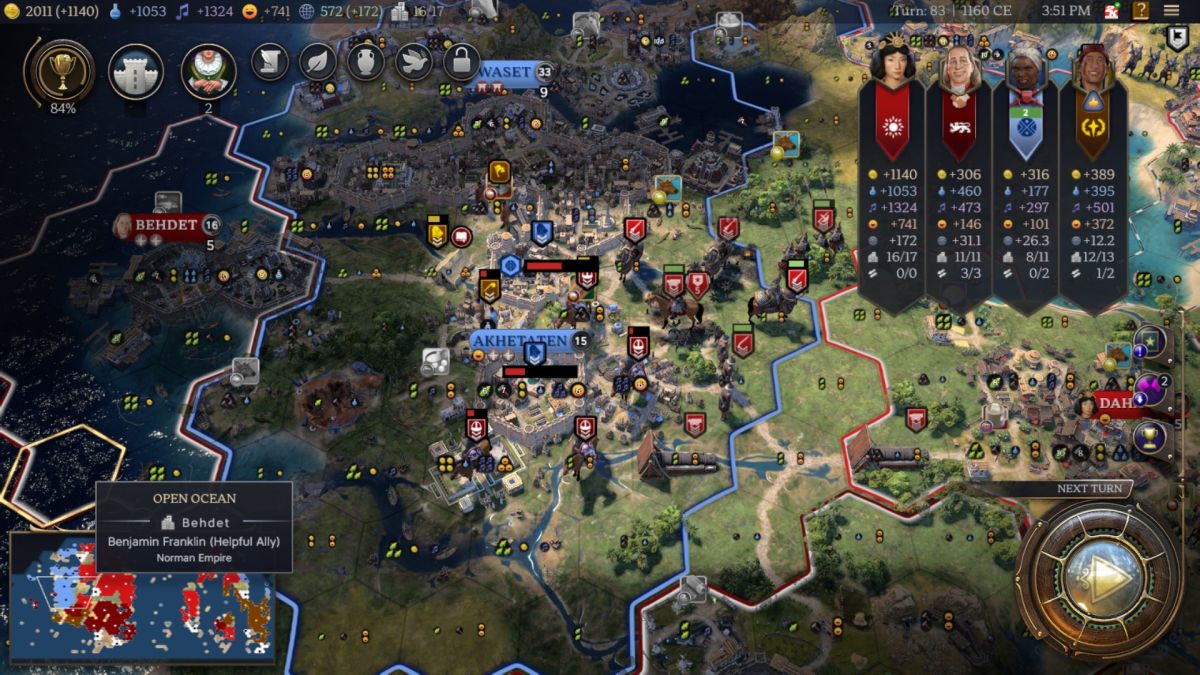
Since I was the civ officially declaring war, I took the huge 5 war support penalty for attacking Tubman, along with a further penalty for this being a Surprise War. Thankfully I had influence falling out of my ears and that allowed me to spend more than 2000 influence to flip the war support situation into my favor. Majapahit units advanced on three separate fronts, with the main attack force down here in the southwest pushing into Tubman's core and two smaller squadrons opportunistically trying to seize one of her towns in the northern tundra along with a colony on the eastern continent. She had no defenses at all in the far east where my tier 3 arquebusiers easily blasted their way into the town of Timbuktu; the trickiest part of that capture was making sure that Franklin's random wandering units didn't snipe the settlement. There was more resistance along my western border where I had to fight off a bunch of enemy knights that wandered into my territory near Samara. There was never a chance of my cities falling but I did have to divert a few units to push them back.
The pictured main front was where the hottest fighting took place, though I had known this would be the case and had my best army commander along with a bunch of tier 3 units to go on the attack. I had been purchasing bombards out of my nearest settlement, little Daha, and those things made mincemeat out of the fortified defenses at Akhetatan when operating within the commander's radius. The unfortunate Tubman was also getting attacked by Franklin's Chevaler mounted units and even some of Tecumseh's Kispoko infantry that randomly happened to be in the area. The AI attackers helped me wear down the defenders but wasn't smart enough to understand that it had to capture and hold all of the fortified districts to take the full city. First Akhetatan fell on Turn 84, then I fought my way district by district into Waset to snare it as well on Turn 89:
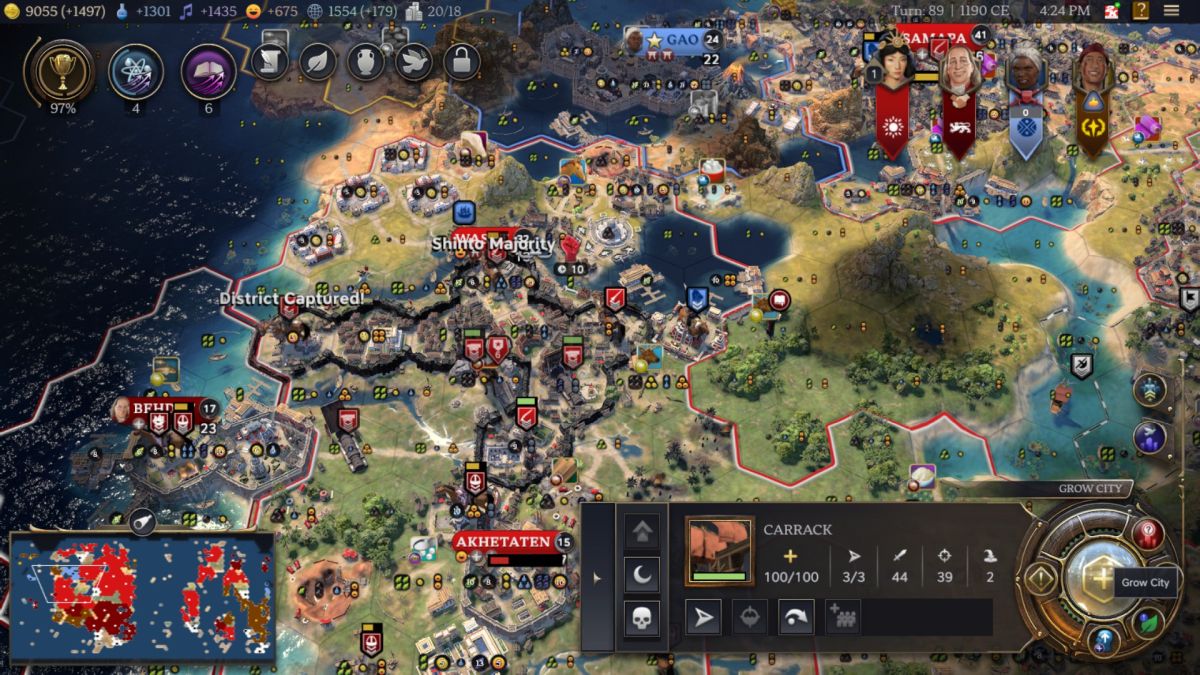
This was by far the most fortified districts that I'd seen to date in Civ7, with eight of them in total here at Waset. Most of them had fallen relatively quickly though I know things would have been much tougher if I hadn't brought three bombards along for the offensive. For all of my criticisms of this game, the Civ7 AI is vastly better at defending itself than the completely helpless Civ6 AI. I had also taken another Tubman settlement directly north of here in the tundra, and in a normal Civilization game, I would have pushed on to Tubman's final remaining continental city at Gao to complete the campaign. However, Gao had an extraordinarily strong defensive position with mountainous barriers to the east and west, a lake to its south, and an ocean to its north. It was vulnerable to an attack by sea but I lacked ships on this ocean due to a lack of any ports over here. That was the sort of thing that I could fix with time, not at the moment though.
The larger reason why I couldn't capture Gao though was the idiotic era meter. The whole world was engaged in this tense, apocalyptic struggle against Harriet Tubman only for some disembodied clock to tell everyone that they had to stop everything and make way for an era transition. I had been nervously watching the percentage in the corner of the screen, holding off on completing all of my various scoring goals, as it had increased from 84% to 97% over the half dozen turns of the war. When the meter ticked up another point to 98% on the following Turn 90, I didn't think that I could wait any longer to act. This would be the final turn of the era; I began by cashing in my accumulated treasure fleets:
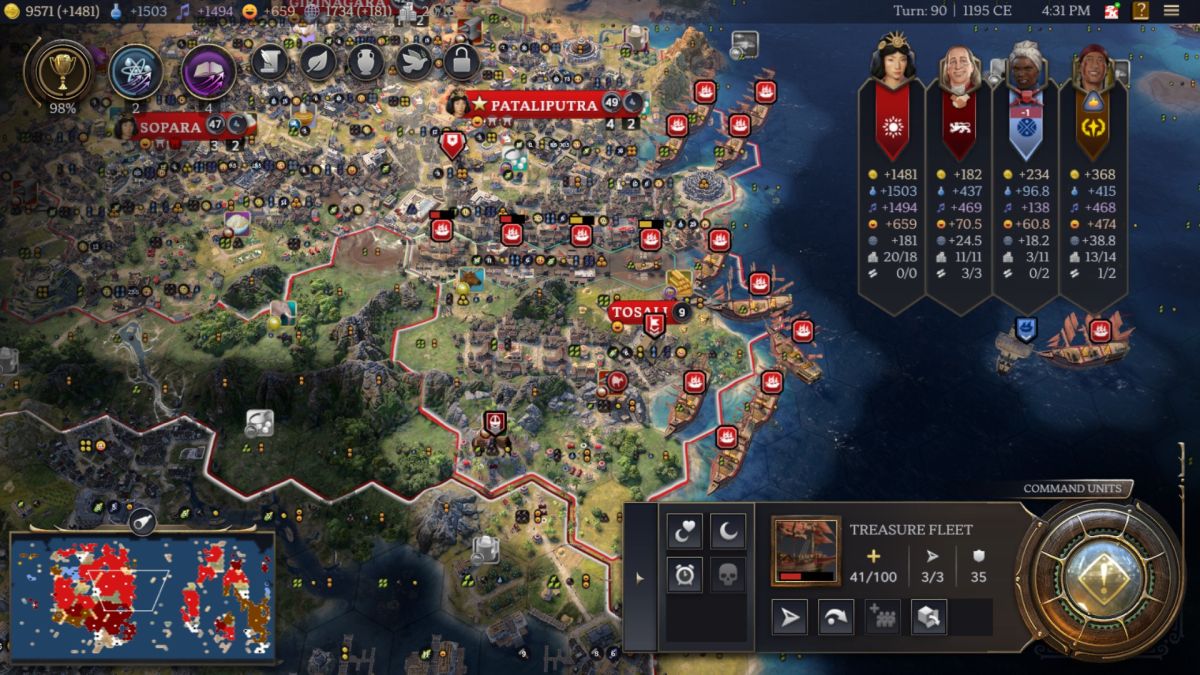
There they all were, clustered in huge numbers around the mouth of Pataliputra's small river. Under the One Unit Per Tile rules they were unable to stack atop one another, thus causing this silly traffic jam, and a bunch of them had taken damage from yet another river flooding disaster on the interturn. I returned all of these accumulated treasure fleets at once, increasing the scoring counter from 8/30 to 33/30, whew, just barely making it over the necessary margin. I would not have made it if I hadn't been delaying the era transition since the Exploration age otherwise would have finished sometime around Turn 80 or possibly even sooner. I think that I only brought the final remaining treasure fleets home some time around Turn 85 or 86. Then it was time to have my parked missionaries spread my religion in the cities over on the distant lands continent:
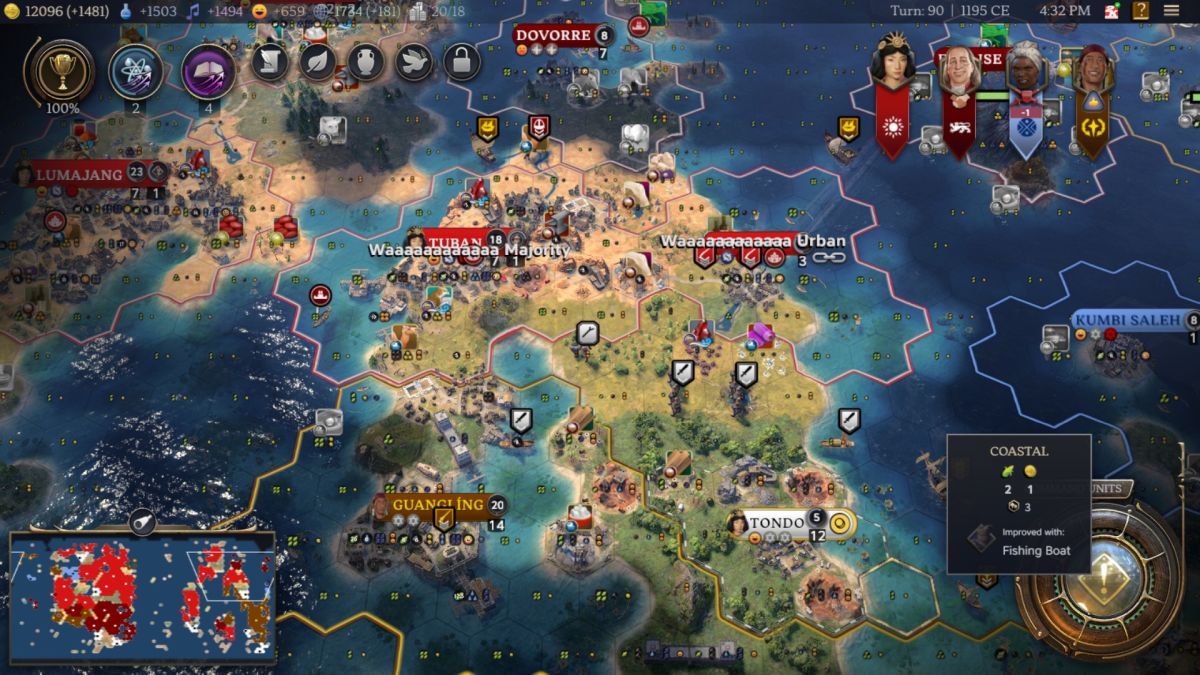
I had to include this image as it showed multiple settlements where Waaaaaaaaaaaa became the dominant faith. I'd been sitting at 6/12 on the Military scoring for some time, then capturing Timbuktu increased this to 8/12 points, and converting five of my cities at once easily boosted my civ over the top. You would think that this was the religious scoring goal, but nope, spreading your religion to your distant lands settlements makes them worth double points for some unknown reason. The Cultural legacy path is the one involving those relics and I slotted in the last remaining relics to complete that goal as well. It was something else that I could have done easily at a far earlier date, and in a better designed game I would have wanted to do so, but here in Civ7 I had to delay until the last possible second. Finishing all of these scoring goals simultaneously would have boosted the era meter to at least 125% if it could go that high, maybe as much as 130%. Yes, this is an idiotic system.

And this was an overview of my empire's core at the end of Turn 90 with the Exploration age coming to a close. Pataliputra, Girinagara, and Sopara had all grown to the point that they formed a massive megalopolis; while this is kind of cool to see the cities grow together into a big clump, it's also hard to avoid the sense that the whole thing becomes a cluttered mess somewhere around this point. The age was finishing with my Majapahit nation in complete and utter dominance over the rest of the world. I had almost double the territory of everyone else, my science and cultural output were approaching 4x the rate of Tecumseh, and my gold/turn income was approximately double everyone else combined. This game was clearly over and Civ7's gameplay should be able to determine that I had reached a winning position followed by providing an exit path. Instead, it does exactly the opposite by trying to "catch up" the hopelessly behind AI emipres by cramming everyone closer together with the era transitions. These things aren't fun to play and they don't even serve their purpose; as readers will see, the AI civs never had a chance in the Modern era either.
Since the game wasn't ending here, I spent several thousand gold upgrading some of the captured Tubman towns into cities. I didn't know that you could upgrade a town into a city while it's in resistance but apparently yes, you can. A certain amount of gold and influence can be carried across the era transition, though of course Civ7 doesn't tell the player how much that is. I kept about 8000 gold in the bank to see how much would survive and it turned out that I was able to keep 3000 of it (technically 3441 gold in a really bizarre number). That meant that something like 5000 gold went up in smoke to no point at all; I guess I'll just have to remember that there's an arbitrary 3000-ish gold limit for my future games.
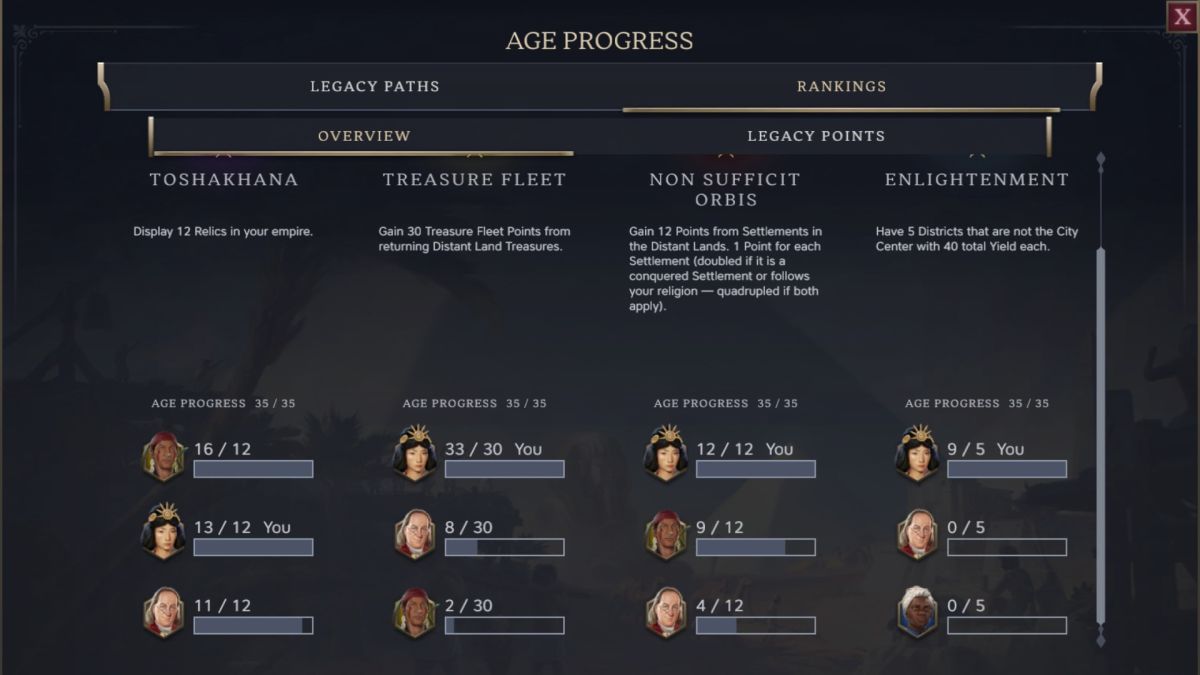
This was the final legacy scoring for the Exploration age and this was the first time that I completed all four scoring goals simultaneously. Most of them aren't actually that tough to do, it's more a matter of memorizing the various idiosyncrasies for each one and then understanding how to achieve them with a minimum of effort. As I've said a bunch of times before, these scoring goals would be far better suited to a one-off scenario than being part of the main Civ7 gameplay. They ask the player to do the same thing, over and over again, game after game, and get boring really quickly. Obviously I can pull them off without too much trouble, even here on Deity difficulty, but I don't really want to keep endlessly following the same legacy paths since they're so tedious. Unfortunately, if I don't engage in the treasure fleet bonanza, I get the prize of losing all my cities when the next era starts. Fun times indeed. 
Making matters worse, the AI starts to fall apart here in the Exploration age when it comes to the legacy scoring. While the AI leaders can chase after everything reasonably well in the Ancient era, they can only score points in half the categories here in the second era. They can always collect the relics with their missionary spam - my goodness do they love to train those missionaries! - and they can follow the Military path to at least some degree since they will settle the distant lands and capture settlements from one another. However, they are failures at the Economic path (where Franklin's 8/30 score was the highest I had ever seen an AI achieve) and absolutely abysmal when it comes to the Scientific category. That one requires intelligent city building and good specialist placement which the AI simply cannot achieve. Their city development is atrociously bad and the AI gold/science/culture yields are propped up with MASSIVE cheats under the hood when playing on higher difficulty. It's a terrible sign that this whole legacy scoring system, which needs competition between the various empires to function, instead has an AI that can't compete in the slightest for fully half of the four categories.
And that has real effects as far as why the AI collapses over the course of the gameplay. Remember, the Economic golden age allows the player to maintain all of their cities as cities instead of losing them back into towns once again. I would be able to preserve all of my cities and have them hit the ground running at the start of the Modern era. But the AI is laughably bad at this legacy scoring category, so they never achieve the Economic golden age, so they never get to preserve their cities. Franklin and Tecumseh and so on could only start the Modern era with a maximum of two cities. I was going to start the next age with FOURTEEN cities!!! How could they ever hope to compete with me from that kind of position? How could the Modern era ever be anything but a boring push to a predetermined victory condition with the other AI empires so crippled before the race even began?
This is why the entire era concept sucks so badly: it's horribly unfun while simultaneously being a total flop at its supposed goal of creating closer, more exciting endgames. Not great, Bob! On to the Modern era to wrap up this game.



